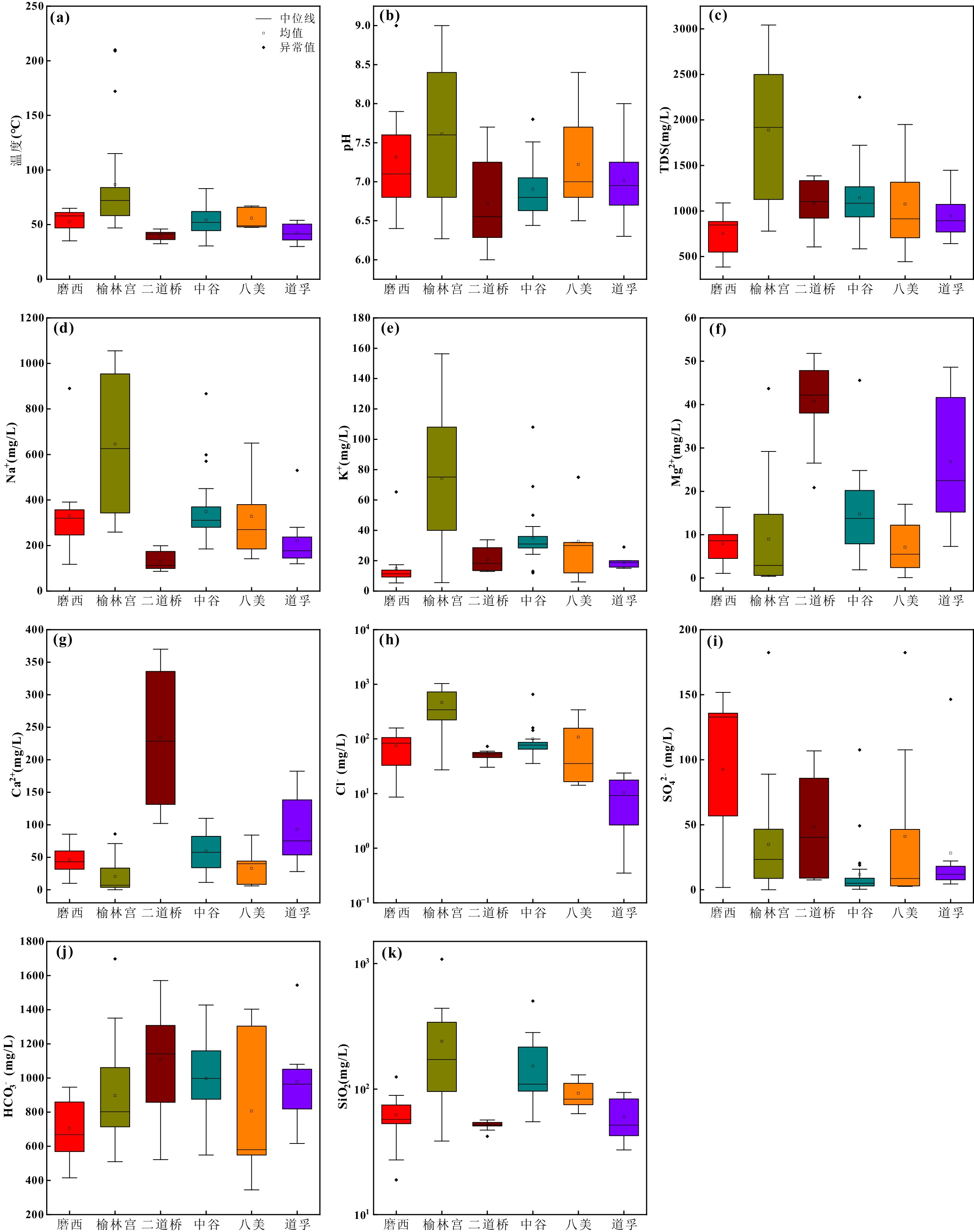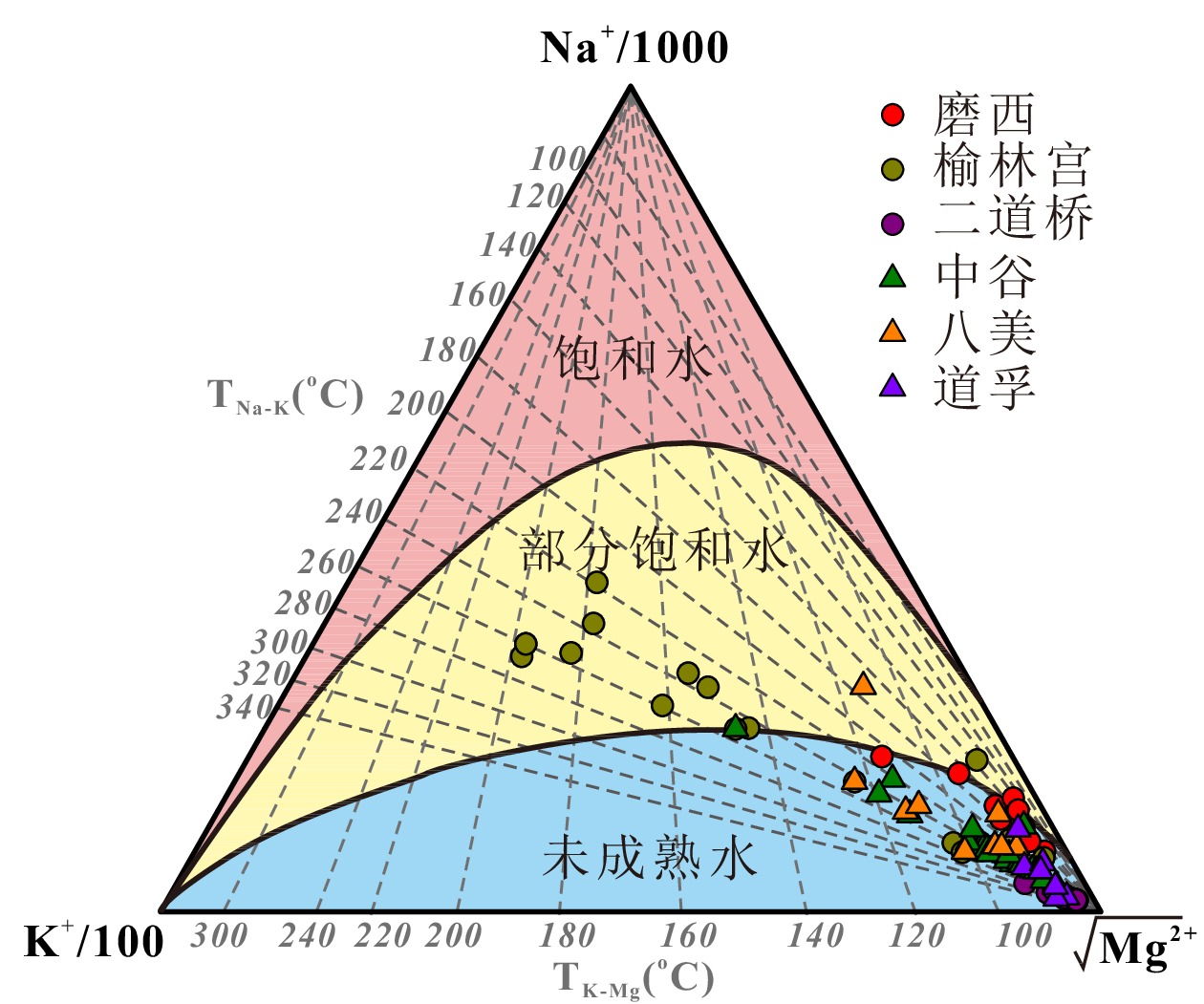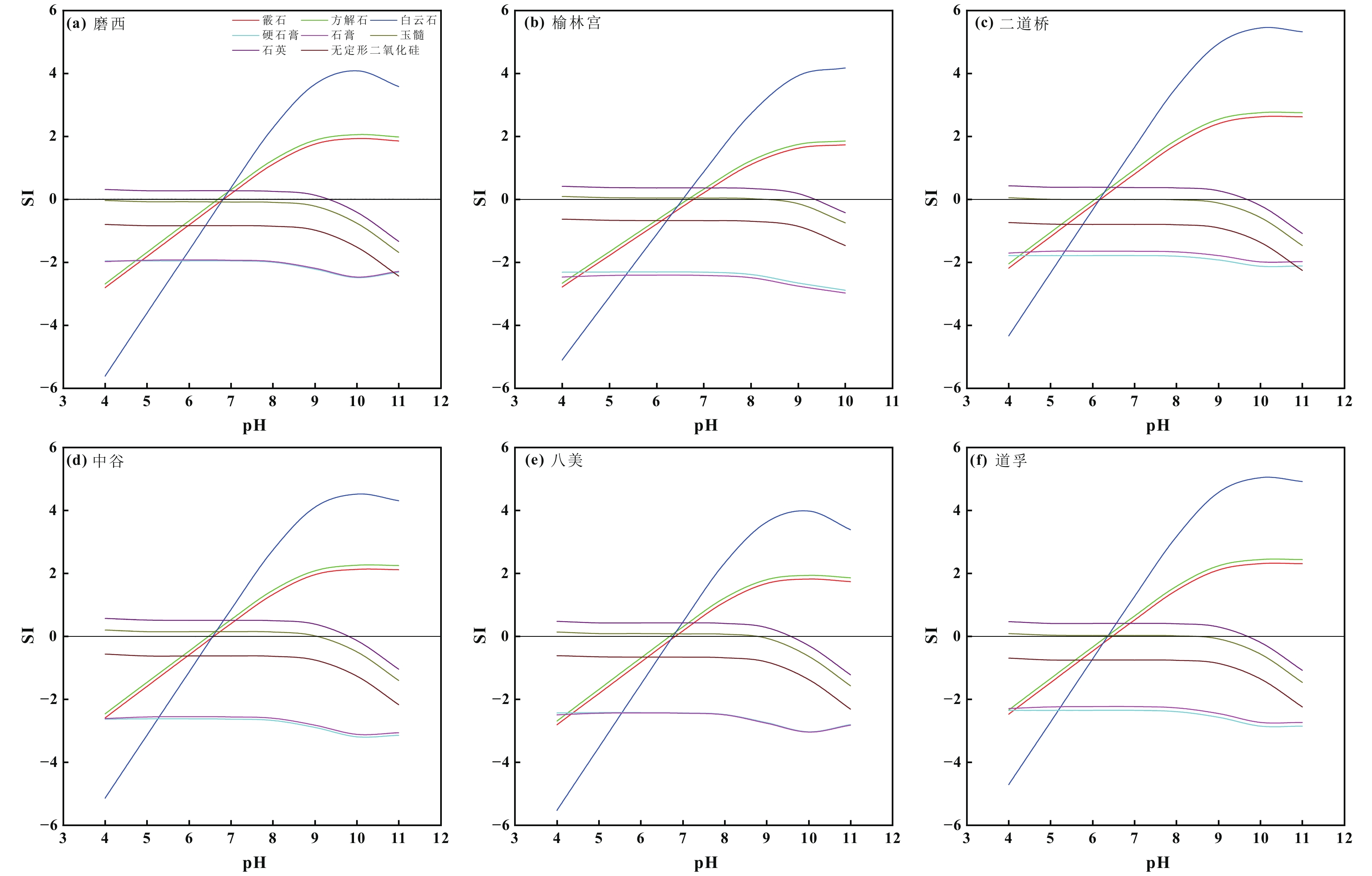Geothermal water chemical characteristics and scaling analysis of Xianshuihe fault zone
-
摘要:
地热资源作为潜力巨大的清洁能源,大力开发地热资源是我国实现双碳目标的重要路径。川西鲜水河断裂带地热资源丰富,但地热结垢成为了地热资源开发利用中的主要问题之一。为进一步查明地热资源的赋存状态和结垢趋势特征,本文以鲜水河断裂带上的磨西、榆林宫、二道桥、中谷、八美和道孚地热区为研究区,采用水化学分析、氢氧同位素、热储温度估算和结垢趋势特征分析等方法,开展了鲜水河断裂带地热水水化学及结垢趋势特征研究。结果表明:地热水的水化学类型主要为Na-HCO3、Ca-HCO3、Ca·Na-HCO3和Na-Cl·HCO3型;地热水主要来源于大气降水的补给且氧漂移现象明显;地热水均未达到完全的水-岩平衡状态,混合冷水后的浅部热储温度为61℃~172℃,深部初始热储温度平均值为183℃~284℃,冷水混合比例平均值为77%~86%;指数分析法和饱和指数判别法得出以上地热区均有可能形成碳酸盐结垢,硅酸盐结垢仅可能会形成于少数SiO2含量异常高的区域,而硫酸盐结垢几乎不形成;依据硅-焓模型估算的冷水混合比例重构得出深层储层流体组分,计算得出二道桥地区的碳酸盐结垢程度是最严重的,主要是因为该区的热储岩性为碳酸盐岩,以及热储温度能促进CaCO3沉淀。对于除垢和预防,可以采用机械拆除、控制CO2分压、控制溶液的pH值和使用化学添加剂(阻垢剂)等。研究成果可为鲜水河断裂带及川西地热资源的可持续开发利用提供理论依据。
Abstract:Geothermal resources have great potential as clean energy, and can be used to achieve the goal of carbon peaking and carbon neutrality. The Xianshuihe fault zone in western Sichuan is rich in geothermal resources, but geothermal scaling has become one of the main problems in the development and utilization of geothermal resources. In order to further identify the occurrence state and scaling trend characteristics of geothermal resources, this paper takes the six areas of Moxi, Yulingong, Erdaoqiao, Zhonggu, Bamei and Daofu on the Xianshuihe fault zone as the research area, and uses water chemistry analysis, hydrogen and oxygen isotopes, heat storage temperature estimation and scaling trend characteristics analysis to carry out the geothermal water hydrochemistry and scaling trend characteristics of the Xianshuihe fault zone. The results show that the hydrochemical types of geothermal water are mainly Na-HCO3, Ca-HCO3, Ca·Na-HCO3 and Na-Cl·HCO3; Geothermal water mainly comes from the supply of atmospheric precipitation and oxygen drift occurs in most areas; The geothermal water has not reached the complete water-rock equilibrium state, and the shallow geothermal reservoir temperature is 61℃~172℃. The average temperature of deep thermal reservoir is 183℃ to 283℃, and the average cold water mixing ratio is 77% to 86%; The exponential analysis method and the saturation index discrimination method show that carbonate scaling may occur in the all above geothermal areas. Silicate scaling may only occur in several areas with abnormally high SiO2 content, while sulfate scaling almost does not occur. According to the cold water mixing ratio estimated by the silicon-enthalpy model, the fluid composition of the deep reservoir is reconstructed. Combined with the formula, it is calculated that the carbonate scaling degree in the Erdaoqiao area is the most serious, mainly because the reservoir lithology in the area is carbonate salt, and the reservoir temperature can promote the precipitation of CaCO3. For descaling and prevention, mechanical removal, control of CO2 partial pressure, control of solution pH, and use of chemical additives (scale inhibitors) can be used. The research results can provide a theoretical basis for the sustainable development and utilization of geothermal resources in the Xianshuihe fault zone and western Sichuan.
-

-
图 1 (a) 鲜水河断裂带区域构造位置图和 (b) 鲜水河断裂带地热区分布图 (根据文献李晓等, 2018, Li et al., 2020a, 张云辉等, 2021, 唐渊等, 2022修改)
Figure 1.
图 2 (a、b) 康定县城某高温地热井结垢照片(王延欣等, 2015, 张恒等, 2016);(c、d) 二道桥地区地热水结垢照片;(e、f) 老榆林地区龙头沟和灌顶地热水结垢照片
Figure 2.
图 3 鲜水河断裂带地热水水化学参数箱型图。(a)温度(℃);(b)pH;(c)TDS(mg/L);(d) Na+ (mg/L);(e) K+ (mg/L);(f) Mg2+ (mg/L);(g) Ca2+ (mg/L);(f) Cl-(mg/L);(i) SO42-(mg/L);(j) HCO3-(mg/L);(k) SiO2 (mg/L) (数据来源于附表1
1 )Figure 3.
图 4 鲜水河断裂带地热水的Piper三线图(Piper, 1944)(图中椭圆分别对应四种水化学类型;数据来源于附表1
1 )Figure 4.
图 5 鲜水河断裂带地热水的δD和δ18O关系图(数据来源于附表1
1 )Figure 5.
图 6 鲜水河断裂带地热水的Na-K-Mg三角图(Giggenbach, 1988)(数据来源于附表1
1 )Figure 6.
图 7 (a) 鲜水河断裂带地热水的lg(K2/Mg)/lg(SiO2)比值图和 (b) 硅—焓模型图(数据来源于附表1
1 )Figure 7.
表 1 鲜水河断裂带典型地热区碳酸钙结垢趋势预测结果
Table 1. Prediction results of CaCO3 scaling trend in typical geothermal areas of Xianshuihe fault zone
地区 LI 结垢趋势 RI1 结垢趋势 RI2 结垢趋势 Cl-毫克当量% 磨西 - - 4.24 严重 5.59 中等 13.05 榆林宫 0.98 不结垢 3.90 - - 中等 41.78 二道桥 - - 3.46 非常严重 4.55 严重 7.56 中谷 - - 4.09 严重 5.45 中等 13.07 八美 - - 4.70 严重 6.13 轻微 13.97 道孚 - - 4.05 严重 5.19 中等 1.79 注:表中所有的计算结果均为平均值;1代表取Kc计算;2代表取Ke计算;“-”表示没有计算。 表 2 鲜水河断裂带典型地热区深部流体组分重建结果
Table 2. Reconstruction results of deep fluid components in typical geothermal area of Xianshuihe fault zone
地区 温度(℃) pH Na+ K+ Ca2+ Mg2+ Cl- SO42- HCO3- SiO2 mg/L 磨西 150.0 6.70 994.66 35.91 109.94 20.44 260.47 310.44 2310.89 166.26 榆林宫 150.0 6.68 1102.21 112.24 49.65 37.23 575.86 112.93 2013.39 244.72 二道桥 150.0 6.06 624.05 101.76 822.61 153.16 231.35 236.10 4180.94 203.66 中谷 150.0 6.47 1117.56 106.60 153.72 24.67 252.06 30.83 3131.62 304.17 八美 150.0 6.70 985.47 97.30 36.75 6.92 327.72 98.29 2213.07 262.21 道孚 150.0 6.34 928.99 78.12 299.15 92.15 39.09 78.05 3822.45 226.23 注:pH取各地区方解石达到平衡状态时的值。 -
[1] Akın T, Kargı H, 2019. Modeling the geochemical evolution of fluids in geothermal wells and its implication for sustainable energy production[J]. Geothermics, 77: 115-129. doi: 10.1016/j.geothermics.2018.09.003
[2] Alçiçek H, Bülbül A, Brogi A, et al. , 2017. Origin, evolution and geothermometry of thermal waters in the Gölemezli Geothermal Field, Denizli Basin (SW Anatolia, Turkey)[J]. Journal of Volcanology and Geothermal Research, 349: 1-30.
[3] Ámannsson H, 1989. Predicting calcite deposition in krafla boreholes[J]. Geothermics, 18(1-2): 25-32. doi: 10.1016/0375-6505(89)90006-0
[4] Bai M, Chevalier M-L, Pan J, et al. , 2018. Southeastward increase of the late Quaternary slip-rate of the Xianshuihe fault, eastern Tibet. Geodynamic and seismic hazard implications[J]. Earth and Planetary Science Letters, 485: 19-31. doi: 10.1016/j.jpgl.2017.12.045
[5] Blasch K W, Bryson J R, 2007. Distinguishing sources of ground water recharge by using delta2H and delta18O[J]. Ground Water, 45(3): 294-308. doi: 10.1111/j.1745-6584.2006.00289.x
[6] Bozau E, Häußler S, van Berk W, 2015. Hydrogeochemical modelling of corrosion effects and barite scaling in deep geothermal wells of the North German Basin using PHREEQC and PHAST[J]. Geothermics, 53: 540-547. doi: 10.1016/j.geothermics.2014.10.002
[7] 蔡义汉, 2004. 地热直接利用[M]. 天津: 天津大学出版社.
Cai Y H, 2004. Geothermal Direct−Use[M]. Tianjin: University of Tianjin Press.
[8] Capaccioni B, Vaselli O, Tassi F, et al. , 2011. Hydrogeochemistry of the thermal waters from the Sciacca Geothermal Field (Sicily, southern Italy)[J]. Journal of Hydrology, 396(3-4): 292-301. doi: 10.1016/j.jhydrol.2010.11.015
[9] Chauhan V, Saevarsdottir G, Tesfahunegn Y A, et al. , 2021. Computational study of two-phase flashing flow in a calcite scaled geothermal wellbore[J]. Geothermics, 97: 102239. doi: 10.1016/j.geothermics.2021.102239
[10] Corsi R, 1986. Scaling and corrosion in geothermal equipment: problems and preventive measures[J]. Geothermics, 15(5-6): 839-856. doi: 10.1016/0375-6505(86)90097-0
[11] Craig H, 1961. Isotopic variations in meteoric waters[J]. Science, 133(3465): 1702-1703. doi: 10.1126/science.133.3465.1702
[12] Dawe R A, Zhang Y, 1997. Kinetics of calcium carbonate scaling using observations from glass micromodels[J]. Journal of Petroleum Science and Engineering, 18(3): 179-187.
[13] Delalande M, Bergonzini L, Gherardi F, et al. , 2011. Fluid geochemistry of natural manifestations from the Southern Poroto–Rungwe hydrothermal system (Tanzania): Preliminary conceptual model[J]. Journal of volcanology and geothermal research, 199(1-2): 127-141. doi: 10.1016/j.jvolgeores.2010.11.002
[14] Ellis P, 1983. Review of shell−and−tube heat exchanger fouling and corrosion in geothermal power plant service radian corporation[A].
[15] Erbaş H A, Bozdağ A, 2022. Hydrogeochemical characteristics and evaluation of the geothermal fluids in the Gazlıgöl geothermal field (Afyonkarahisar), Western Anatolia, Turkey[J]. Geothermics, 105: 102543. doi: 10.1016/j.geothermics.2022.102543
[16] Fournier R O, 1977. Chemical geothermometers and mixing models for geothermal systems[J]. Geothermics, 5(1-4): 41-50. doi: 10.1016/0375-6505(77)90007-4
[17] Giggenbach W F, Glover R B, 1992. Tectonic regime and major processes governing the chemistry of waterand gas discharges from the Rotorua geothermal field, New Zealand[J]. Geothermics, 21(1-2): 121-140. doi: 10.1016/0375-6505(92)90073-I
[18] Giggenbach W F, 1988. Geothermal solute equilibria. derivation of Na-K-Mg-Ca geoindicators[J]. Geochimica et cosmochimica acta, 52(12): 2749-2765. doi: 10.1016/0016-7037(88)90143-3
[19] Guo Q, Pang Z H, Wang Y C, et al. , 2017. Fluid geochemistry and geothermometry applications of the Kangding high-temperature geothermal system in eastern Himalayas[J]. Applied Geochemistry, 81: 63-75. doi: 10.1016/j.apgeochem.2017.03.007
[20] Jiang G Y, Wen Y M, Liu Y J, et al. , 2015. Joint analysis of the 2014 Kangding, southwest China, earthquake sequence with seismicity relocation and InSAR inversion[J]. Geophysical Research Letters, 42(9): 3273-3281. doi: 10.1002/2015GL063750
[21] 姜哲, 周训, 陈柄桦, 等, 2022. 四川康定市二道桥地区地下热水稳定同位素特征及热储温度计算[J]. 现代地质, 36(4): 1183-1192 doi: 10.19657/j.geoscience.1000-8527.2022.04.20
Jiang Z, Zhou X, Chen B H, et al, 2022. Stable Isotope Characteristics of Geothermal Water and Calculation of Geothermal Reservoir Temperature in the Erdaoqiao Area of Kangding in Sichuan Province[J]. Geoscience, 36(4): 1183-1192. doi: 10.19657/j.geoscience.1000-8527.2022.04.20
[22] Kiaei Z, Haghtalab A, 2014. Experimental study of using Ca-DTPMP nanoparticles in inhibition of CaCO3 scaling in a bulk water process[J]. Desalination, 338: 84-92. doi: 10.1016/j.desal.2014.01.027
[23] Kong Y L, Pang Z H, Shao H B, et al. , 2014. Recent studies on hydrothermal systems in China: a review[J]. Geothermal Energy, 2(1): 1-12. doi: 10.5194/gtes-2-1-2014
[24] Kong Y L, Wang K, Li J, et al. , 2019. Stable Isotopes of Precipitation in China: A Consideration of Moisture Sources[J]. Water, 11(6): 1239. doi: 10.3390/w11061239
[25] Larson T E, Sollo F R, 1967. Loss in Water Main Carrying Capacity[J]. Journal (American Water Works Association), 59(12): 1565-1572. doi: 10.1002/j.1551-8833.1967.tb03486.x
[26] 雷宏武, 白冰, 崔银祥, 等, 2023. 高温地热生产井碳酸钙结垢定量评价: 水文地球化学—以西藏羊八井为例[J]. 地球科学48(3): 935 − 945
Lei H W, Bai B, Cui Y X, et al, 2023. Quantitative Assessment of Calcite Scaling of a High Temperature Geothermal Production Well: Hydrogeochemistry—Application to the Yangbajing Geothermal Fields, Tibet[J]. Earth science, 48(3): 935 − 945.
[27] Li J X, Yang G, Sagoe G, et al. , 2018. Major hydrogeochemical processes controlling the composition of geothermal waters in the Kangding geothermal field, western Sichuan Province[J]. Geothermics, 75: 154-163. doi: 10.1016/j.geothermics.2018.04.008
[28] Li X, Huang X, Liao X, et al. , 2020a. Hydrogeochemical Characteristics and Conceptual Model of the Geothermal Waters in the Xianshuihe Fault Zone, Southwestern China[J]. International Journal of Environmental Research and Public Health, 17(2): 500-514. doi: 10.3390/ijerph17020500
[29] 李晓, 王金金, 黄珣, 等, 2018. 鲜水河断裂带康定至道孚段热水化学与同位素特征[J]. 成都理工大学学报(自然科学版), 45(6): 733-745 doi: 10.3969/j.issn.1671-9727.2018.06.09
Li X, Wang J J, Huang X, et al, 2018. Chemical and isotopic characteristics of hot water in the Kangding-Daofu section of Xianshuihe fault zone, Sichuan, China[J]. Journal of Chengdu University of Technology(Science & Technology Edition), 45(6): 733-745. doi: 10.3969/j.issn.1671-9727.2018.06.09
[30] 李义曼, 庞忠和, 2018. 地热系统碳酸钙垢形成原因及定量化评价[J]. 新能源进展, 6(4): 274-281
Li Y M, Pang Z H, 2018. Carbonate Calcium Scale Formation and Quantitative Assessment in Geothermal System[J]. Advances in New and Renewable Energy, 6(4): 274-281.
[31] Li Y M, Pang Z H, Galeczka I M, 2020b. Quantitative assessment of calcite scaling of a high temperature geothermal well in the Kangding geothermal field of Eastern Himalayan Syntax[J]. Geothermics, 87: 101844. doi: 10.1016/j.geothermics.2020.101844
[32] Liu Q Q, Shi Y N, Wei D P, et al. , 2017. Near-surface Geothermal Gradient Observation and Geothermal Analyses in the Xianshuihe Fault Zone, Eastern Tibetan Plateau[J]. Acta Geologica Sinica - English Edition, 91(2): 414-428. doi: 10.1111/1755-6724.13108
[33] Liu W, Guan L F, Liu Y, et al. , 2022. Fluid geochemistry and geothermal anomaly along the Yushu-Ganzi-Xianshuihe fault system, eastern Tibetan Plateau: Implications for regional seismic activity[J]. Journal of Hydrology, 607: 127554. doi: 10.1016/j.jhydrol.2022.127554
[34] Lu L H, Pang Z H, Kong Y L, et al. , 2018. Geochemical and isotopic evidence on the recharge and circulation of geothermal water in the Tangshan Geothermal System near Nanjing, China: implications for sustainable development[J]. Hydrogeology Journal, 26(5): 1705-1719. doi: 10.1007/s10040-018-1721-6
[35] Luo J, Pang Z H, Kong Y K, et al. , 2017. Geothermal potential evaluation and development prioritization based on geochemistry of geothermal waters from Kangding area, western Sichuan, China[J]. Environmental Earth Sciences, 76(9): 2-24.
[36] Peralta Arnold Y, Cabassi J, Tassi F, et al. , 2017. Fluid geochemistry of a deep-seated geothermal resource in the Puna plateau (Jujuy Province, Argentina)[J]. Journal of Volcanology and Geothermal Research, 338: 121-134. doi: 10.1016/j.jvolgeores.2017.03.030
[37] Piper A, 1944. A Graphic Procedure in the Geochemical Interpretation of Water-Analyses[J]. Eos Transactions American Geophysical Union, 25: 914-923. doi: 10.1029/TR025i006p00914
[38] Satman A, Ugur Z, Onur M, 1999. The effect of calcite deposition on geothermal well inflow performance[J]. Geothermics, 28: 425-44. doi: 10.1016/S0375-6505(99)00016-4
[39] Singh C K, Kumar A, Shashtri S, et al. , 2017. Multivariate statistical analysis and geochemical modeling for geochemical assessment of groundwater of Delhi, India[J]. Journal of Geochemical Exploration, 175: 59-71. doi: 10.1016/j.gexplo.2017.01.001
[40] Tang X C, Zhang J, Pang Z H, et al. , 2017. The eastern Tibetan Plateau geothermal belt, western China: Geology, geophysics, genesis, and hydrothermal system[J]. Tectonophysics, 717: 433-448. doi: 10.1016/j.tecto.2017.08.035
[41] Tang X C, Zhang J, Pang Z H, et al. , 2016. Distribution and genesis of the eastern Tibetan Plateau geothermal belt, western China[J]. Environmental Earth Sciences, 76(1): 1-15.
[42] 唐渊, 王鹏, 邓红, 等, 2022. 青藏高原东缘鲜水河断裂带南东段渐新世以来主要构造岩浆事件的岩石记录[J]. 地质通报, 41(7): 1121-1143 doi: 10.12097/j.issn.1671-2552.2022.07.001
Tang Y, Wang P, Deng H, et al, 2022. Petrological records of major tectono-magmatic events since Oligocene in the southeastern segment of Xianshuihe fault zone in the eastern margin of Tibetan Plateau[J]. Geological Bulletin of China, 41(7): 1121-1143. doi: 10.12097/j.issn.1671-2552.2022.07.001
[43] Tapponnier P, Molnar P, 1977. Active faulting and tectonics in China[J]. Journal of Geophysical Research, 82(20): 2905-2930. doi: 10.1029/JB082i020p02905
[44] Truesdell A, Fournier R, 1977. Procedure for estimating the temperature of a hot-water component in a mixed water by using a plot of dissolved silica versus enthalpy[J]. USGS J Res, 5: 49-52.
[45] Wang E, Burchfiel B C, Royden L H, et al. , 1998. Late Cenozoic Xianshuihe-Xiaojiang, Red River, and Dali fault systems of Southwestern Sichuan and Central Yunnan, China[J]. Special Paper of the Geological Society of America, 327: 1-108.
[46] 王奎峰, 杨德平, 宋香锁, 等, 2010. 临清市馆陶组地热水化学特征及结垢腐蚀性研究[J]. 水文地质工程地质, 37(1): 130-134 doi: 10.3969/j.issn.1000-3665.2010.01.026
Wang K F, Yang D P, Song X S, et al, 2010. Chemical characteristics and encrustment and erosion of geothermal water in the Guantao Formation in Linqing[J]. Hydrogeology & Engineering Geology, 37(1): 130-134. doi: 10.3969/j.issn.1000-3665.2010.01.026
[47] Wang Y C, Gu H Y, Li D, et al. , 2021. Hydrochemical characteristics and genesis analysis of geothermal fluid in the Zhaxikang geothermal field in Cuona County, southern Tibet[J]. Environmental Earth Sciences, 80(11): 415. doi: 10.1007/s12665-021-09577-8
[48] 王延欣, 刘世良, 边庆玉, 等, 2015. 甘孜地热井结垢分析及防垢对策[J]. 新能源进展, 3(3): 202-206
Wang Y X, Liu S L, Bian Q Y, et al, 2015. Scaling Analysis of Geothermal Well from Ganzi and Countermeasures for Anti-scale[J]. Advances in New and Renewable Energy, 3(3): 202-206.
[49] Wanner C, Eichinger F, Jahrfeld T, et al. , 2017. Unraveling the Formation of Large Amounts of Calcite Scaling in Geothermal Wells in the Bavarian Molasse Basin: A Reactive Transport Modeling Approach[J]. Procedia Earth and Planetary Science, 17: 344-347. doi: 10.1016/j.proeps.2016.12.087
[50] 韦梅华, 2012. 四川省康定县地下热水结垢机理及趋势分析[D]: 中国地质大学(北京).
Wei M H, 2012. Analysis of the scaling Mechanism and Trend of Thermal Groundwater in Kangding County of Sichuan Province[D]. China University of Geosciences(Beijing).
[51] 韦梅华, 田廷山, 孙燕冬, 等, 2012. 四川省康定地区地热水结垢趋势分析[J]. 水文地质工程地质, 39(5): 132-138 doi: 10.16030/j.cnki.issn.1000-3665.2012.05.029
Wei M H, Tian T S, Sun Y D, et al, 2012. A study of the scaling trend of thermal groundwater in Kangding county of Sichuan[J]. hydrogeology & engineering geology, 39(5): 132-138. doi: 10.16030/j.cnki.issn.1000-3665.2012.05.029
[52] Xu S, Guan L F, Zhang M L, et al. , 2022. Degassing of deep-sourced CO2 from Xianshuihe-Anninghe fault zones in the eastern Tibetan Plateau[J]. Science China Earth Sciences, 65(1): 139-155. doi: 10.1007/s11430-021-9810-x
[53] 杨东方, 唐令龙, 1995. 西藏地热井除垢[J]. 四川电力技术, 18(4): 8-10
Yang D F, Tang L L, 1955. Scales Removal of Geothermal Well in Xizang[J]. Sichuan electric power technology, 18(4): 8-10.
[54] 张恒, 胡亚召, 云智汉, 等, 2016. 水文地球化学模拟技术在康定某高温地热井结垢研究中的应用[J]. 新能源进展, 4(2): 111-117
Zhang H, Hu Y Z, Yun Z H, et al, 2016. Applying Hydro-Geochemistry Simulating Technology to Study Scaling of the High-Temperature Geothermal Well in Kangding County[J]. Advances in New and Renewable Energy, 4(2): 111-117.
[55] Zhang P Z, 2013. A review on active tectonics and deep crustal processes of the Western Sichuan region, eastern margin of the Tibetan Plateau[J]. Tectonophysics, 584: 7-22. doi: 10.1016/j.tecto.2012.02.021
[56] Zhang Y P, Dawe R, 1998. The kinetics of calcite precipitation from a high salinity water[J]. Applied Geochemistry, 13(2): 177-184. doi: 10.1016/S0883-2927(97)00061-9
[57] Zhang Y H, He Z H, Tian H H, et al. , 2021. Hydrochemistry appraisal, quality assessment and health risk evaluation of shallow groundwater in the Mianyang area of Sichuan Basin, southwestern China[J]. Environmental Earth Sciences, 80(17): 576. doi: 10.1007/s12665-021-09894-y
[58] 张云辉, 2018. 鲜水河断裂康定−磨西段地热系统成因及开发利用研究[D]: 成都理工大学.
Zhang Y H, 2018. Research on genesis and development of the geothermal system in the Kangding−Moxi segment of the Xianshuihe fault[D]: Chengdu University of Technology.
[59] 张云辉, 李晓, 许模, 等, 2021. 鲜水河地热带道孚地区地热水水文地球化学特征研究[J]. 安全与环境工程, 28(3): 42-51
Zhang Y H, Li X, Xu M, et al, 2021b. Hydrogeochemical Characteristics of Geothermal Waters in the Daofu Area of the Xianshuihe Geothermal Belt[J]. Safety and Environmental Engineering, 28(3): 42-51.
[60] Zhang, Y., Farquhar, R., 2001. Laboratory determination of calcium carbonate scaling rates for oilfield wellbore environments. In: Proceedings of International Symposium on Oilfield Scale. Society of Petroleum Engineers.
[61] Zhang Y P, Shaw H, Farquhar R, et al. , 2001. The kinetics of carbonate scaling—application for the prediction of downhole carbonate scaling[J]. Journal of Petroleum Science Engineering, 29(2): 85-95. doi: 10.1016/S0920-4105(00)00095-4
[62] Zhang Y H, Xu M, Li X, et al. , 2018. Hydrochemical Characteristics and Multivariate Statistical Analysis of Natural Water System: A Case Study in Kangding County, Southwestern China[J]. Water, 10(1): 80. doi: 10.3390/w10010080
[63] 赵斌, 吕玥, 温柔, 等, 2023. 西藏地热能开发利用现状及发展前景[J]. 热力发电: 52(1): 1 − 6
Zhao B, Lyu Y, Wen R, et al., 2023. Utilization situation and development prospect of geothermal energy in Tibet[J]. Thermal Power Generation: 52(1): 1 − 6.
[64] 赵友年, 1981. 从鲜水河断裂带演化史谈鲜水河雁行式断裂带与地震活动的关系[J]. 四川地震, (3): 10-14
Zhao Y N, 1981. Discussion on the relationship between the Xianshuihe en echelon fracture fracture and seismic activity from the evolution history of Xianshuihe fracture[J]. Earthquake Research in Sichuan, (3): 10-14.
[65] 朱家玲, 姚涛, 2004. 地热水腐蚀结垢趋势的判断和计算[J]. 工业用水与废水, 35(2): 23-25 doi: 10.3969/j.issn.1009-2455.2004.02.007
Zhu J L, Yao T, 2004. Judgement and Calculation of Trend of Corrosion and Scaling of Geothermal Water[J]. Industaial Waters & Wastewaters, 35(2): 23-25. doi: 10.3969/j.issn.1009-2455.2004.02.007
-




 下载:
下载:







